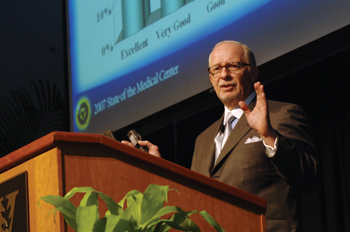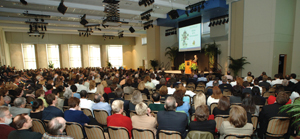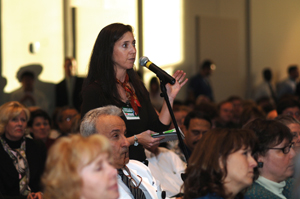
Harry Jacobson, M.D., delivers the State of the Medical Center address Monday at the Student Life Center. (photo by Anne Rayner)
Jacobson outlines bold vision for VUMC

Harry Jacobson, M.D., outlines VUMC’s performance during the past year at Monday’s address in the Student Life Center. (photo by Anne Rayner)

Shari Barkin, M.D., chief of General Pediatrics, asks a question during the State of the Medical Center address. (photo by Anne Rayner)
Building on the success of a 10-year strategic plan set for Vanderbilt University Medical Center in 1998, Vice Chancellor for Health Affairs Harry Jacobson, M.D., formalized a new vision for the medical campus and its employees Monday during his annual State of the Medical Center address.
It has been a decade since Jacobson assumed the Medical Center's helm, and several goals set at that time have now been met — in many cases, well ahead of schedule.
“If you look at 1998, our Medical Center budget was $811 million,” Jacobson said. “We said by 2008 we would reach $1.4 billion and a lot of people thought that would not be possible. And our budget for [2007] is now about $2 billion.
“In 1998 we were sitting at about 2.5 million square feet of space in the Medical Center, and in 2008 we are sitting at about 4.5 million square feet.”
Jacobson outlined 'Vision 2020,' which will expand the academic medicine mission of “Research, Training, Patient Care” to a flywheel model that demonstrates how “Working in New Ways, Getting Results that Matter, Transferring Knowledge” lead to a central focus of “Impact on Society.”
Areas identified as a top priority for Vision 2020 are chronic disease and end-of-life care, both of which represent a large — and growing — cost to society.
Jacobson commented on medical education in America today as generally being “bound in tradition,” slow to use technology, poorly suited to the rapid pace of change and having a focus on curing rather than preventing.
He said challenges facing the nation's health systems include an aging population, the acceleration of immigration, pace of scientific change, consumer empowerment and choice.
Shortages exist nationwide in the areas of manpower, cash to pay for care and capital to expand facilities.
An important component of this year's address was Jacobson's announcement that VUMC is in negotiations for an off-campus location at the 100 Oaks Mall site off Thompson Lane, which sits on roughly 57 acres and contains abundant parking options.
Details on how the property may be used have yet to be determined.
Jacobson reviewed the vision and goals he set forth in his 1998 State of the Medical Center Address to measure VUMC progress over the past decade.
VUMC is thriving when considering that most of what may have been seen as lofty projections a decade ago have already been met or exceeded.
Research dollars have grown from $120 million in 1998 to $360 million forecast for 2007, which is $40 million ahead of the 10-year plan.
“In 1997, when I came in, we had great basic science departments in NIH funding,” Jacobson said. “We said, at that time, you couldn't be a top medical center unless you have clinical departments that lead in NIH funding.”
NIH funding on the clinical side has made major strides since 1997, with Pediatrics currently ranking sixth in the nation (up 10 spots), Medicine is up from 22 to seven, Surgery has leaped from 38 to 14 and Radiology is up 36 spots from 45 to 10.
Basic sciences departments have remained at the top of their respective fields since 1997 with Biochemistry (2), Physiology (1), Pharmacology (4) and Cell Biology now ranking fifth in the nation as compared to its 11th position in 1997.
The research enterprise was challenged in 1998 to increase its productivity per square foot by 50 percent ($350 per square foot) while adding 400,000 square feet of research space — it now produces $479 per square foot with 578,000 square feet of new research space.
“In 1998 we said our research goal was to increase the productivity of our existing research space by 50 percent,” Jacobson said. “They said it couldn't be done.”
VUMC has grown its faculty from 1,022 in 1998 to 1,800 in 2007 and Institute of Medicine members have more than tripled, from five to 16.
Jacobson projected the number of endowed chairs would grow from 46 to 82 by 2008, but reported Monday that VUMC has 124 endowed chairs for 2007.
Jacobson's address was structured around the five elevate pillars — People, Service, Quality, Growth and Finance. Each pillar has yearly and long-term goals attached to it.
In People, VUMC is working to continue to improve its results in the Community Survey.
“We are striving to be one of Fortune Magazine's Top 100 Places to Work and we would be the first academic medical center to reach that goal,” Jacobson said.
“We already believe that we are one of the best places to work — I hear that, I see that, our community survey supports that — but we are really not in that top echelon … the Fortune 100 average scores for the survey are at 84 percentile and we scored a 76 percentile.
“We have learned a lot from our surveys over the last eight or so years. We have learned that there are areas we need to work on … we have learned that our physicians here sometimes feel that they do not have enough influence over key decisions.”
Other areas of focus include cross-unit collaboration, pay and success sharing and staffing as it relates to national benchmarking the category.
Also mentioned were ways to strengthen department communications, the practice of transparent budgeting and leader communication.
Key strengths from the 2006 Community Survey, Physician Survey and Fortune Survey include VUMC's commitment to mission, meaning of the work, quality of care, team performance, and the category of “People we report to.”
The 2007 Community Survey is slated for March 19-30, and Jacobson has set a goal of 90 percent participation for VUMC personnel.
From a finance perspective, VUMC has immediate goals to increase net revenue at hospitals and clinics by 5.9 percent or more and by 6.1 percent or more for the Vanderbilt Medical Group.
Uncompensated care increased by 23 percent in fiscal year 2007 — from $97.4 million to $119.9 million.
Additionally, the number of self-pay patients were up 30 percent over fiscal year 2006 and 168 percent over fiscal year 2005.
The uncompensated care rate is up to 7.6 percent as compared to 4.6 percent in fiscal year 2005.
Jacobson said solutions include increased payment rates for adults and children, new funding for Level I Trauma Centers and federal approval of a $131 million Disproportionate Share Pool for Tennessee that needs to grow to $400 million by 2010.
He criticized the nation’s health care system as being “inefficient,” at times unsafe, mediocre, and slow to adopt new science or respond to challenges and threats.
The future will undoubtedly present some tough medical education challenges, Jacobson said, as the demand for doctors exceeds the supply pipeline and the ratio of future earnings to cost of education declines.













